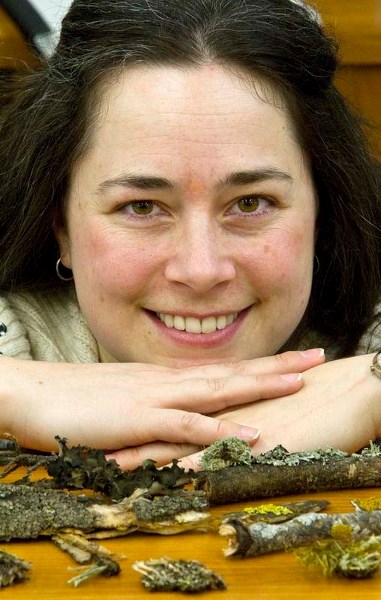They're some of the strangest lovers in the world, and they're probably hanging out in your backyard right now.
They're lichens – symbiotic twosomes of algae and fungi that have been together for thousands of years – living together right under our noses.
And an Edmonton researcher wants to share her love for them with you next week.
Lichenologist Diane Haughland is hosting a free talk this Feb. 12 at the Royal Alberta Museum called When Algae Met Fungi: a lichen love story. The talk is part of the museum's curatorial lecture series, which highlights new research and collections at the museum.
There are about 800 known species of lichen in Alberta, Haughland said. Most people overlook them, but lichen are everywhere from the Arctic to the Antarctic – places where algae and fungi on their own would be unlikely to survive.
"Somehow, together they form this unique body that can survive extreme habitats and live on little more than mist and dust."
Haughland said she picked a Valentine's Day theme for her talk to highlight this relationship.
"It's basically a lifestyle choice they've made."
Tiny twosomes
Most lichens are a partnership between a specific fungi and a specific algae, the two of which are nearly impossible to notice when apart, Haughland said.
The fungus is able to talk to and influence the alga to produce more food for it, while the fungus produces a strong, sealed shell in which to house the algae.
How this happens is a mystery, Haughland said, as lichens are very tough to grow and study in the lab.
"They just don't want to do it in captivity!" she laughed.
You're likely to encounter four types of lichen around St. Albert, Haughland said.
The grey starburst lichen is grey and features many tiny cups – the fruiting bodies of the fungus – and is known for its resistance to urban pollution, Haughland explained.
Rotting wood might be host to pixie cup lichens, which look like tiny wine goblets. Grey shield lichen (which resemble battered pieces of metal) typically hang out on trees, while orange sunburst lichen prefer spots with high levels of nitrogen.
You have to get nose-to-nose with most lichen to appreciate their vivid colours and intricate nooks, crannies and folds. Haughland suggests using a magnifying glass if you're interested.
Some lichens are so small that their features are invisible without a microscope. The British soldier lichen has twisty branches capped with what looks like red-cap mushrooms, all of which are maybe a millimetre wide.
Run a finger across a lichen and it's likely to come away covered with coloured powder. Haughland said these pollen-like structures are used for asexual reproduction. Drop them somewhere and they'll grow if conditions are right.
Other lichens will reproduce when the fungal portion releases spores. These spores float on the wind until they encounter their preferred algae, at which point they pair up and get growing.
Handy little things
Lichens are an important food source for many creatures – particularly caribou – as well as a traditional source of dyes for the First Nations, Haughland said. They can also shelter mites and bugs in their folds, acting as a miniature forest, and harvest nitrogen for use by plants.
Lichens are sensitive to air pollution and are a good indicator of air quality, said St. Albert air quality consultant David Spink.
Since they absorb all their nutrients from the air directly, lichen act as natural air quality monitoring stations, tracking levels of nitrogen, sulphur, and heavy metals. Researchers have already used this around Fort McMurray to validate the results of air quality models, Spink said.
Lichen diversity is another indicator, as some lichens are more pollution-sensitive than others.
Spink said his trees in St. Albert have lichen all over them, which tells him that the air here is pretty good. Toronto, in contrast, is considered a "lichen desert" due to its relative lack of lichens, suggesting poor air quality.
Lichen Talk
Diane Haughland's lichen talk is at 7 p.m. next Wednesday. Visit royalalbertamuseum.ca for details.




